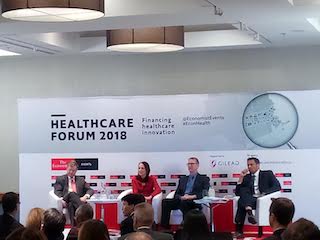 The healthcare innovation industry is a multifaceted ecosystem: From the energetic new startup developing a product and the venture firm backing it, to the FDA regulating the new invention, there are plenty of forces working in concert.
The healthcare innovation industry is a multifaceted ecosystem: From the energetic new startup developing a product and the venture firm backing it, to the FDA regulating the new invention, there are plenty of forces working in concert.
At The Economist’s Healthcare Forum in Boston today, healthcare industry leaders discussed the balancing act of working with key players in this system.
“It is a complex ecosystem and has to be viewed in an integrated way,” Margaret Hamburg, former FDA commissioner and foreign secretary at the National Academy of Medicine, said during a session.
Business is one of that system's key players. Adam Koppel, managing director at Bain Capital, said that on his end he sees three major players: the large established companies, the startups, and the investors. But each has its own role and motivations.
While the larger companies have the advantage of infrastructure in order to sustain their success, they still need a shift towards innovation instead of looking only at cash flow, he said. On the other hand, young startups have drive to succeed and are incentivized primarily by equity.
Then there are the investors, whose goal is making a good return on their investments.
“[Investors] see the lion coming over their shoulder at all times,” Koppel said.
Getting the actual innovations to patients is another struggle in the ecosystem. One of the biggest hurdles in healthcare innovation is the price tag, according to David Cutler, the Otto Eckstein Professor of Applied Economics at Harvard University.
“The cost issue is first order of importance. You can have whatever inventions you [want] but if people can’t afford them they won’t do any good,” Cutler said.
Insurance companies will pay for a large portion of that cost, but for people without coverage the products are often unattainable.
“You have the problem that you are either just inventing for rich people or you are going to have to deal with the pricing,” Cutler said.
He cited industry waste as one of the largest cost drivers, with a key example being those patients who are overtreated.
Presenters at the event also spoke about the role of regulating bodies in the ecosystem.
“Innovation only matters if it works and makes a difference in the lives of people, and benefits outweigh the risk and unmet needs,” Hamburg said.
Hamburg said that in the past, the FDA has been overly cautious at points but overall has worked as a partner to accomplish the industry's goals. Essentially, if the drugs or devices don’t work that would increase waste rather than helping.
“One reason the regulator is value added is because no one wants to pay for something that doesn’t work, or might work for some people but not for others,” Hamburg said.
Koppel said that when he is working with startups he actually sees FDA's regulation guidelines as a positive. These help innovators think about what the FDA is going to be looking for when they are developing a product, which is safety first and benefits second, Koppel said.
While the FDA’s requirements are known to be complex, things could soon be changing on the digital health side. Currently, the FDA is conducting a pilot pre-certification program for medical devices that will focus not on particular products, but on firms and developers. If the FDA is satisfied that the firm is responsible and safe in its development, then it won't need to regulate each product from that firm.
But one theme that all of the players stressed was that healthcare innovation is unique in that the priority is patients.
“I think we are talking about new ways of doing things that make a difference to patients and the health and wellbeing to the general population,” Vivek Muthu, chief health adviser for The Economist Intelligence Unit, and moderator for the session, said.

















